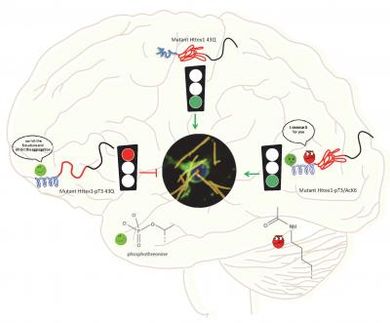Technique enables precise control of protein activity in living cells
Cancer occurs when human cells move and multiply inappropriately. Within cells, a process called phosphorylation serves as an on/off switch for a number of cellular processes that can be involved in cancer, including metabolism, transcription, configuration, movement, cell death and differentiation. This process is controlled by a group of enzymes called protein kinases that – working together and separately – modify the structure of proteins, changing them and allowing them to control cellular processes.
One of the challenges to understanding the actions and interactions of kinases within cells has been that the mechanisms scientists used to control the enzymes were not specific, often affecting more than one pathway within the cell.
In a paper published in the journal Nature Biotechnology , Klaus Hahn, PhD, who is the Thurman Professor of Pharmacology at the University of North Carolina at Chapel Hill and a member of UNC Lineberger Comprehensive Cancer Center, describes a new technique called engineered allosteric regulation, which provides a new tool for scientists who study the interactions of proteins within living cells. "Engineered allosteric regulation is a new method that provides precise control of kinase activity in living cells," said Hahn.
"We can now take the kinase of choice and precisely control the 'on/off' switch, thereby seeing what they are doing and how they control cell function. The technology has exciting applications in basic research, since kinases are the central regulators of almost every cellular process. The ability to precisely control the state and timing of kinase action within cells opens the door to a broad range of new scientific insights," he added. "This ingenious method offers a powerful new approach for dissecting the diverse functions of kinases in living cells," said James Deatherage, PhD, who oversees cell biology grants at the NIH's National Institute of General Medical Sciences. "The capacity to precisely control the activity of this important class of proteins in living cells is a transformational advance in our ability to understand their roles in normal processes like cell growth and development, as well as their part in triggering diseases like cancer."
Hahn explains that the mechanism of engineered allosteric regulation can be compared to the wheels on a car. A small part of each kinase molecule is key to its action within the cell. Attaching a protein engineered by Andrei Karginov to this part of the kinase causes the molecule to vibrate, keeping it from working well enough to control the cell just as loose bolts on a car wheel will keep the vehicle from moving forward effectively. Scientists then use a drug to bind the engineered protein, tightening up the molecule and allowing the kinase to work normally – like tightening the bolts on a car wheel.
"It's very precise. Just as you can map which switch in the circuit box in your home controls specific lights and appliances, this mechanism controls specific kinases, allowing researchers to trace their action precisely within the cell," Hahn says.
Hahn predicts that the new technique will enable faster, less expensive study of cell signaling pathways implicated in cancer as well as a large range of human diseases and disorders.
Hahn points out that this was a highly collaborative effort, made possible only by combining the skills of UNC researchers from diverse disciplines. The research team from UNC includes molecular biologist Andrei V. Karginov, PhD, Research Assistant Professor of Pharmacology, and computational biologists Feng Ding, Research Assistant Professor of Pharmacology, Pradeep Kota, a graduate student in biochemistry and biophysics, and Nikolay V. Dokholyan, PhD, Associate Professor of Biochemistry and Biophysics.
Most read news
Topics
Organizations
Other news from the department science
These products might interest you

Kjel- / Dist Line by Büchi
Kjel- and Dist Line - steam distillation and Kjeldahl applications
Maximum accuracy and performance for your steam distillation and Kjeldahl applications

AZURA Purifier + LH 2.1 by KNAUER
Preparative Liquid Chromatography - New platform for more throughput
Save time and improve reproducibility during purification

Get the analytics and lab tech industry in your inbox
By submitting this form you agree that LUMITOS AG will send you the newsletter(s) selected above by email. Your data will not be passed on to third parties. Your data will be stored and processed in accordance with our data protection regulations. LUMITOS may contact you by email for the purpose of advertising or market and opinion surveys. You can revoke your consent at any time without giving reasons to LUMITOS AG, Ernst-Augustin-Str. 2, 12489 Berlin, Germany or by e-mail at revoke@lumitos.com with effect for the future. In addition, each email contains a link to unsubscribe from the corresponding newsletter.
























































